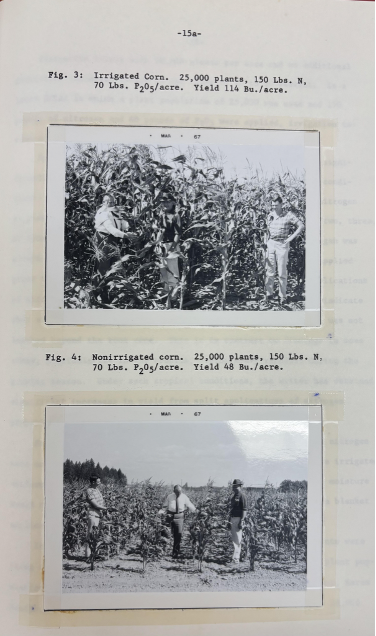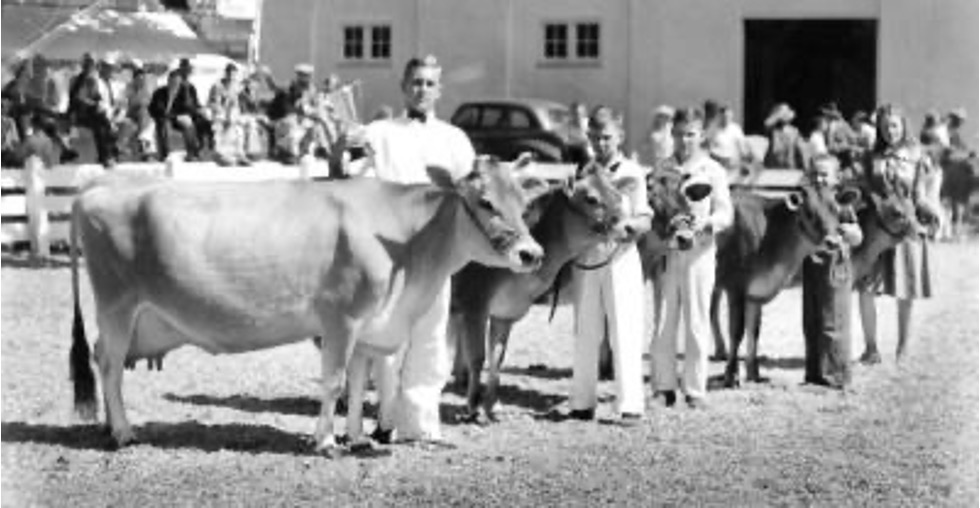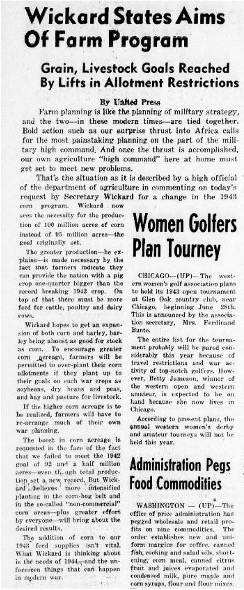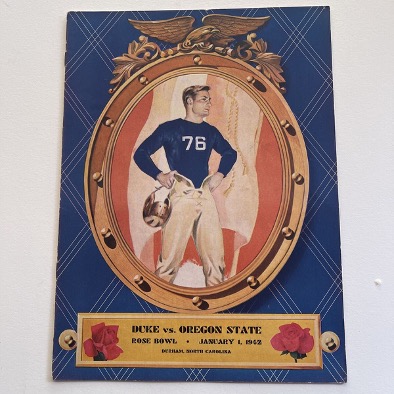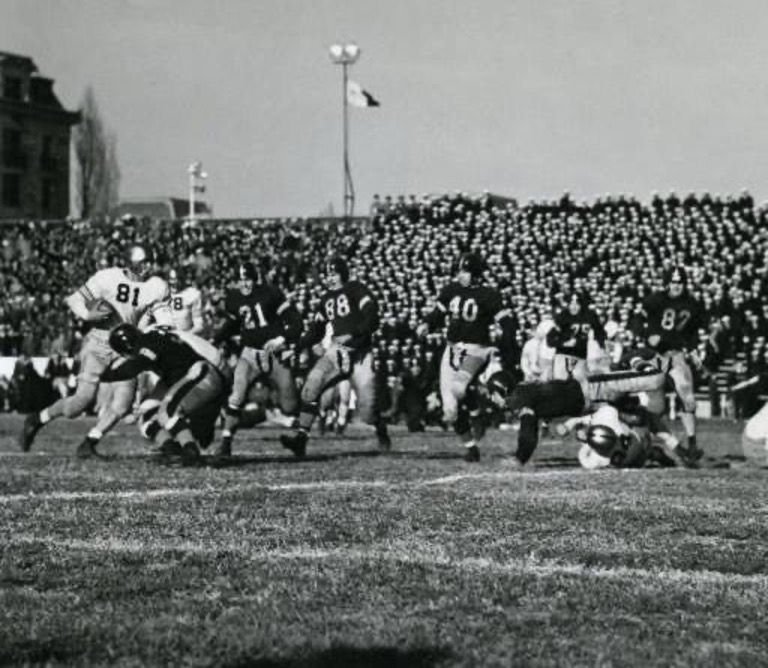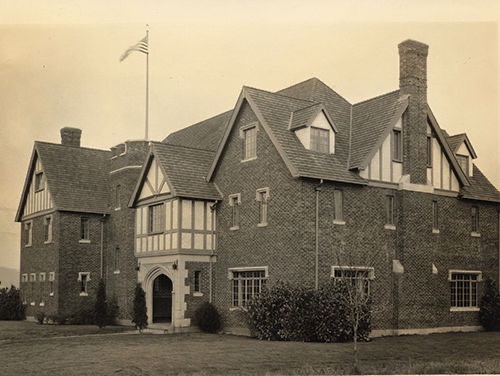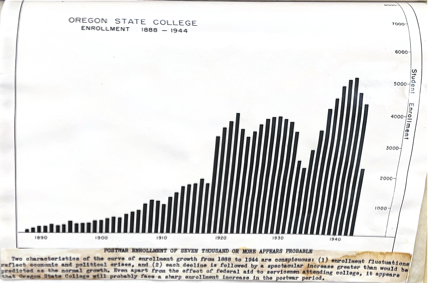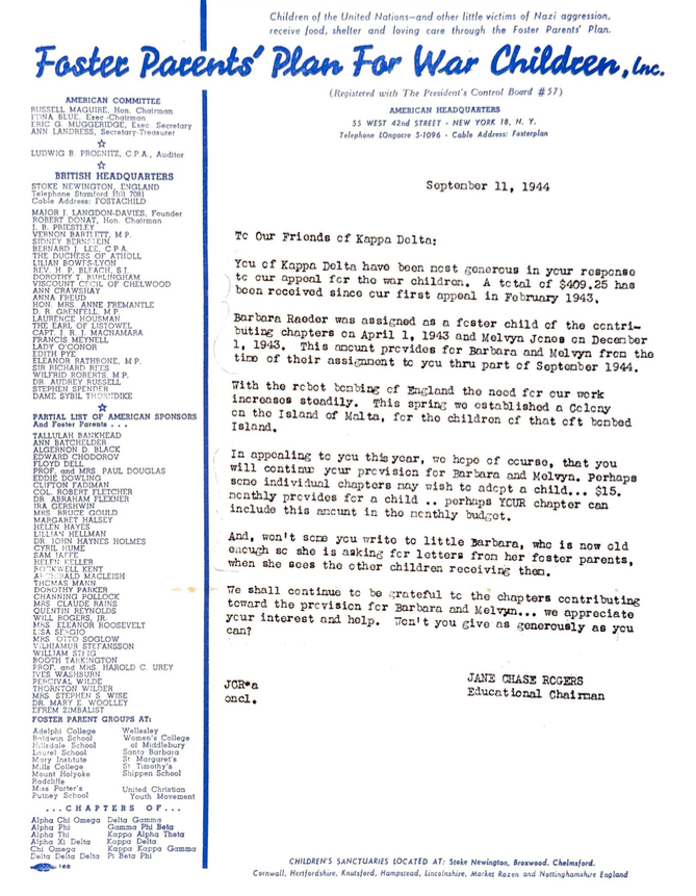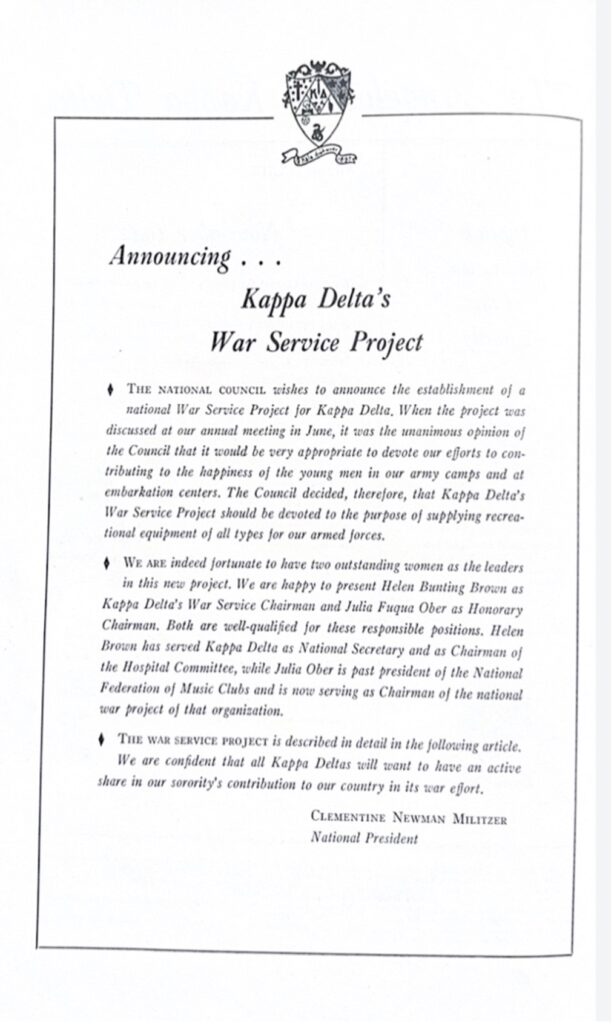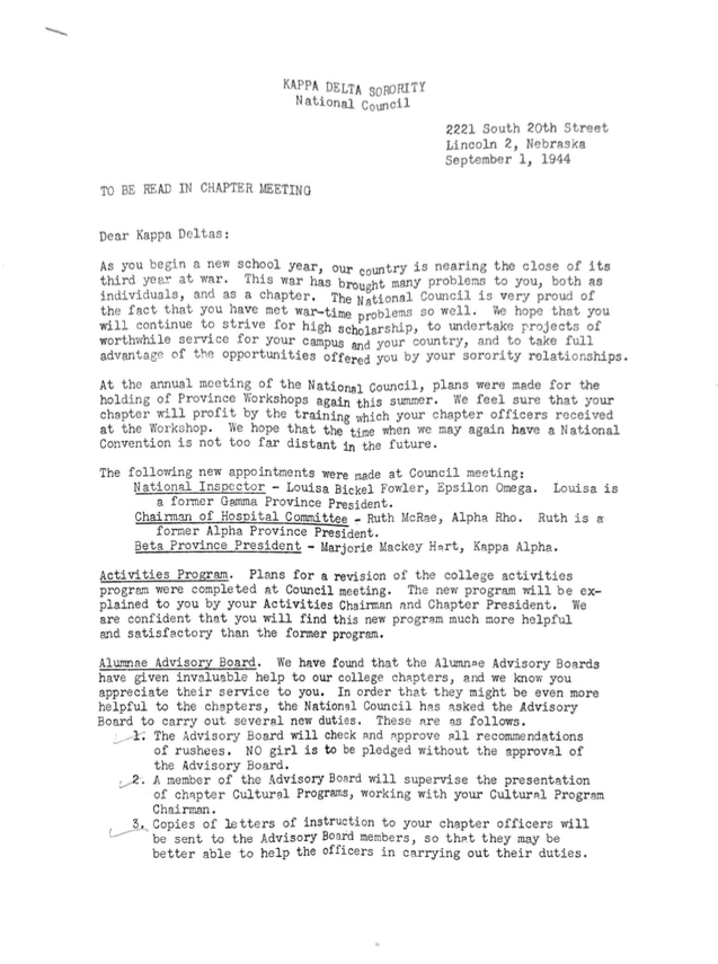During winter term 2025 Dr. Kara Ritzheimer’s History 310 (Historian’s Craft) students researched and wrote blog posts about OSU during WWII. The sources they consulted are listed at the end of each post. Students wrote on a variety of topics and we hope you appreciate their contributions as much as the staff at SCARC does!
Blog post written by Dylan Brady
Picture yourself and your family living your lives when, out of nowhere, you’re forced to leave that life behind. You and your family are moved into a camp with others families and people like you. The conditions are poor and constantly surveilled by armed soldiers and guards within and outside the camp. You don’t have to keep picturing that scenario any longer because all of that was real and experienced by thousands of Japanese Americans who were forcibly relocated by the U.S. government and military into internment camps in reaction to Imperial Japan’s attacks on Pearl Harbor on December 7, 1941. These orders impacted over 100,000 Japanese homeowners, businesses, athletes, and families, but plenty of college students living in these designated west coast military zones dealt with them as well, meaning they also had to leave behind their friends and their studies due to the forced evacuations. A true symbolization of Japanese treatment within these facilities is poem by Janet Matsuda who described her people’s journey as an “Upward Trail.”[i] Within this environment of anti-Japanese sentiment, it is worthwhile to examine how Oregon State College administrators resisted the orders to the best of their ability, which helped give their students the best opportunity to continue their lives outside of internment camps compared to how the rest of the American public reacted. The OSC administration during this time was able to show resistance and determination to clarify questions asked by their students and help them escape being sent to the internment camps.
On April 2, 1942, acting president of Oregon State College, F.A. Gilfillan, sent a letter to all students of Japanese descent who were currently enrolled on campus. The letter itself contains questions that were sent from the office of the president to Lieutenant General John L. DeWitt, commanding lieutenant general of the U.S. Army within the Western Defense Command, on March 27 concerning various proclamations that involved curfews and prohibited areas for those affected by EO9066; the letter also contains DeWitt’s answer to these questions.[ii] This letter was also printed in the Oregon State Barometer, the daily student newspaper,on April 4, 1942, for the whole student body to see.[iii]
The letter asked and answered questions that were an obvious reaction to President Roosevelt’s Executive Order 9066. The Japanese bombed Pearl Harbor on December 7, 1941 and in reaction to that and rising tensions within the U.S., Roosevelt signed the EO on Feb 19, 1942, for reasons that included, “protection against espionage and against sabotage to national-defense material, national-defense premises, and national-defense utilities.”[iv] This order forcibly removed many Japanese Americans and forced them into so-called “relocation camps.” Many Japanese Americans were incarcerated until they were released or most of the camps themselves shut down in 1945. Over 100,000 people were affected and this included plenty of Japanese nationals and those of Japanese descent born in America; plenty of non-Japanese Asian Americans suffered as well.

A notice of civilian exclusion order no. 96 issued John L. Dewitt concerning all “alien” and “non-alien” people of Japanese ancestry and their relocation into military zone 1. Also concerns curfews and the consequences involved if reporting and curfews are not followed.[v]
Despite the U.S. Government and DeWitt not mentioning any specific group, curfews were announced only for Japanese Americans which Gilfillan inquired within his letter to Japanese American students.[vi] The west coast was split by the U.S. government into military zones and at first, DeWitt asked for voluntary evacuations until the president and Congress forced thousands into complying under the threat of imprisonment and fines in March 1942.[vii] The May 26, 1942 issue of the Oregon State Barometer talked about how the U.S. Government issued civilian exclusion orders within 11 counties of Oregon and Washington, including Benton County (OSC’s county), and how students affected would be able to finish the term if they worked fast enough before the orders would kick in on June 1.[viii]
The reactions to this order were mixed; different groups offered plenty of diverse takes on the topic. Many different organizations and groups took to speaking their opinion whether it be to express their support or their disagreements with this act. For example, The Commission on Wartime Relocation and Internment of Civilians, a group appointed by the U.S. Congress in 1980 that conducted a study into the internment of Japanese Americans, and Professor of American Ethnic Studies Tetsuden Kashima, state that West Coast groups like the California Farm Bureau Association and the Western Growers Protection Association demanded stern measures against the Japanese as they felt that this would lead to less economic competition between white and Japanese residents within the agricultural industry; this highlights the animosity that many held towards the those of Japanese descent living in America.[ix] Historian Roger Daniels says that Roger N. Baldwin (1884-1981), the head of the American Civil Liberties Union, responded in a letter stating that protestors had “a strong moral case” but “no legal case at all,” speaking about an upstart movement in Heart Mountain, Wyoming that resisted the orders made by the government.[x] Protestant and Quaker groups provided some resistance, but nothing substantial enough.[xi] Columnists in newspapers as well raised issues involving this forced evacuation like Ernest L. Lindsey of the Richmond Times-Dispatch of Richmond Virginia who argued that third-generation Japanese Americans were devoted to supporting the United States despite himself agreeing with the evacuations for military reasons.[xii] This sentiment was commonplace even after the bombing of Pearl Harbor as some members of the public supported Japanese Americans who were native-born citizens and supported this country. It was unfair to lump them in with the actions of the Imperial Japanese and this belief was further highlighted within the lines of the Oregon State Barometer on December 9, 1941, in a column called “The Unfortunate.”[xiii]

List of students of Japanese ancestry enrolled during the winter term 1942 which would’ve been when EO 9066 would be ordered.[xiv]
Gilfillan and the administration in comparison to the rest of the public offered some resistance. In his aforementioned letter to Japanese American students, he questioned the restrictions that the U.S. government had placed on the Japanese American population, which can be read as a form of pushback. Instead of blindly following such orders, the President asked clarifying questions of DeWitt and even pushed back and asked if students could continue until the current quarter in May or go to summer school.[xv] The OSC administration seemed to have looked for any way to help those affected by the evacuation orders. The archives of the President’s Office of OSC in 1942 contained a proposal for the continued collegiate training of citizens of Japanese ancestry for their purpose involving the leadership of future generations of Japanese Americans. There would be an administration established for an educational program for these students being placed in the hands of a committee of a college/university representing them all.[xvi]

A letter concerning a Hawaiian-born Japanese student enrolled on campus written by T.P. Cramer, Acting Executive Secretary, asking if he can return to his birthplace. He says he would be more equipped to work if he went back home instead of staying on the mainland where he knows little or nothing.[xvii]
Several OSC administrators wanted to help their Japanese students to the best of their ability and that meant helping them travel to other colleges outside of the designated military zones despite the U.S. government’s travel restrictions and avoid the forced relocation onto camps. They asked clarifying questions. T.P. Cramer, Acting Executive Secretary of OSC, sent a telegram on May 20, 1942, to the Wartime Civil Control Administration. In it, he talked about two students of good standing and their possible transfer to the University of Utah; he questioned if they could receive travel permits.[xviii] Another letter that highlighted this care for Japanese American students came in December 18, 1941, from Gilfillan to student Tom Arai where he emphasized with the experiences they’ve faced and will face due to the Pearl Harbor attacks; their loyalty to their college and to America was recognized and felt.[xix]
The responses among the upper faculty within the school highlights something empowering. The care and empathy shown towards their students serves in stark contrast to the responses shown towards Japanese Americans throughout the country and in reaction to the orders of forced evacuation by the government. The administration at OSC wanted to give these students a chance to escape life within these internment camps and somewhere safe at least towards the start of the forced evacuations. This display shows a unity within such a dark period of history showing that OSC treated these students not as enemies, but as fellow peers. Unfortunately, there isn’t much evidence showing that this will to help from OSC administration stayed consistent throughout the period of Japanese internment. It would be nice to think that it did, but there’s just their initial responses we can look at.
This response, unfortunately, wasn’t universal as the attack on Pearl Harbor unified the America against the Imperial Japanese and provided a rationale for denying civil rights to people that were never a danger to U.S. safety. The wave of American nationalism meant justifying the conditions and consequences thousands of Japanese Americans faced. So much was stacked against Japanese Americans at this time from the media, courts, public, and the government themselves. It serves to remind many that real people lived through these forced relocations with their lives forever changed afterward. This is something that still affects generations of Japanese Americans today and even though it may seem easy to think that these events are a thing of the past, the responses of the American public from the highest to lowest in power still ring true in our current world. It is an ugly stain on American history and displays the racism rooted in this country despite its national pride.
Yet within that racism can lie a unity. While it is important to highlight moments of prejudice within our society, it is also important to recognize moments where people come together and stand up for their peers in the face of certain injustices. We need to see examples like that to exemplify and mimic that same behavior when we see others going through their own grievances.
[i] Janet Matsuda, “The Upward Trail,” University of Arkansas Digital Collections, University of Arkansas Libraries, https://digitalcollections.uark.edu/digital/collection/Civilrights/id/1548
[ii] F.A. Gilfillan, “Official Letter to All Japanese Students,” April 2, 1942, Oregon Digital, https://oregondigital.org/concern/documents/df724k98w.
[iii] “Japanese Students,” Oregon State Barometer, April 4, 1942, 2, https://oregondigital.org/concern/documents/df724k71g
[iv] Franklin Roosevelt, “Executive Order 9066: Authorizing the Secretary of War to Prescribe Military Areas, February 19, 1942, https://www.archives.gov/milestone-documents/executive-order-9066.
[v] U.S. Army, “Civilian Exclusion Order No. 96, 1942,” 1942, Digital Public Library of America, http://ark.cdlib.org/ark:/13030/kt1j49p9dz.
[vi] Gilfillan, “Official Letter to All Japanese Students.”
[vii] U.S. National Archives and Records Administration, “Executive Order 9066: Resulting in the Relocation of Japanese Americans,” National Archives, https://www.archives.gov/milestone-documents/executive-order-9066.
[viii] “Japanese are Ordered From 11 Counties,” Oregon State Barometer, May 26, 1942, https://oregondigital.org/concern/documents/df724k72r
[ix] Commission on Wartime Relocation and Internment of Civilians and Tetsuden Kashima, “Personal Justice Denied: Report of the Commission on Wartime Relocation and Internment of Civilians,” University of Washington Press, 1997, 69.
[x] Roger Daniels, “The Japanese American Cases, 1942-2004: A Social History,” Law and Contemporary Problems 68, no. 2 (Spring 2005), 163.
[xi] Ibid., 163.
[xii] Ernest L. Lindley, “On Capitol Hill,” Richmond Times-Dispatch, March 12, 1942, 11, https://www.newspapers.com/image/828036540
[xiii] “The Unfortunate,” Oregon State Barometer, December 9, 1941, 2, https://oregondigital.org/concern/documents/8k71p670p
[xiv] “List of Japanese Students – Winter Term 1942,” Oregon Multicultural Archives, Oregon Digital, https://oregondigital.org/concern/documents/df724m053.
[xv]Gilfillan, “Official Letter to All Japanese Students.”
[xvi] “Proposal for the Continued Collegiate Training of Citizens of Japanese Ancestry Forced by Evacuation Orders to Interrupt Studies,” Oregon Multicultural Archives, Oregon Digital, https://oregondigital.org/concern/documents/df724k79p.
[xvii] T.P. Cramer, “Letter Regarding Student Travel to Hawaii,” April 14, 1942, Oregon Digital, https://oregondigital.org/concern/documents/df724k89x.
[xviii] T.P. Cramer, “Telegram Regarding Student Transfer,” May 20, 1942, Oregon Digital, https://oregondigital.org/concern/documents/df724k81q.
[xix] F. A. Gilfillan, “Letter to the Japanese American Students,” December 18, 1941, sent in response to the December 11, 1941 loyalty letter, Oregon Digital, https://oregondigital.org/concern/documents/df724m08x#citations

